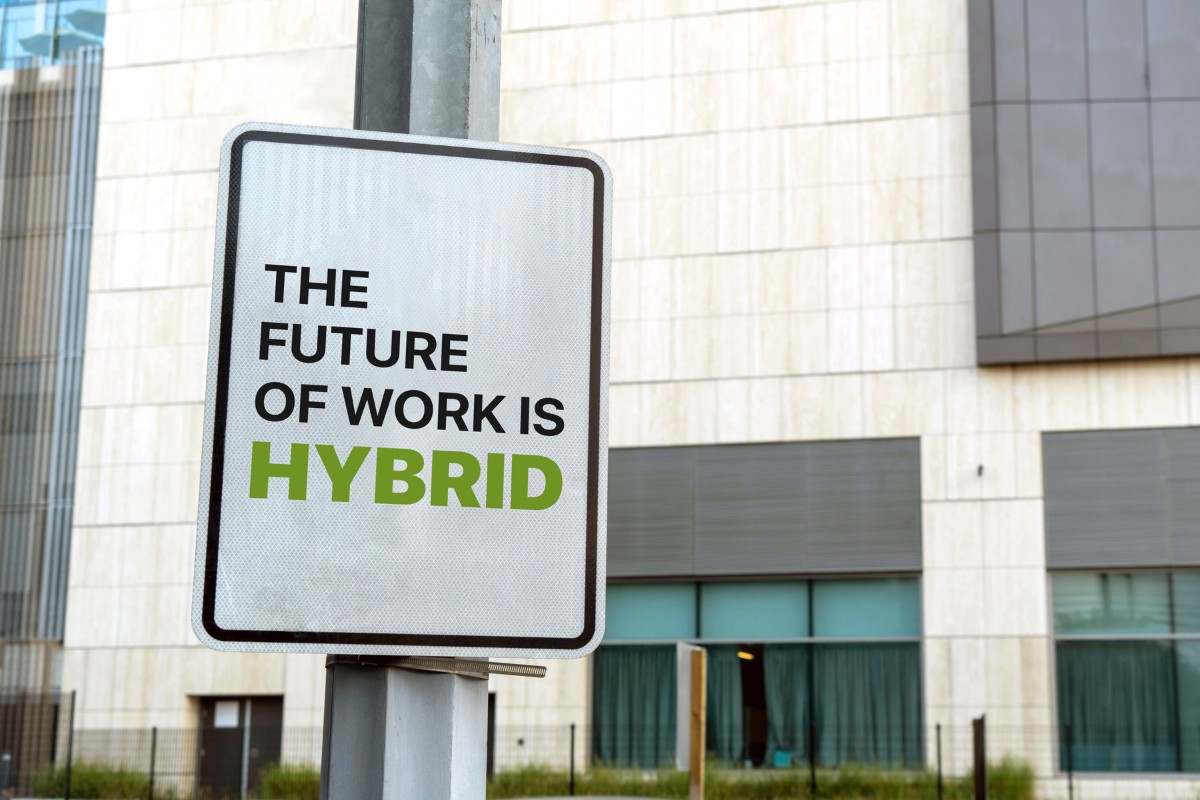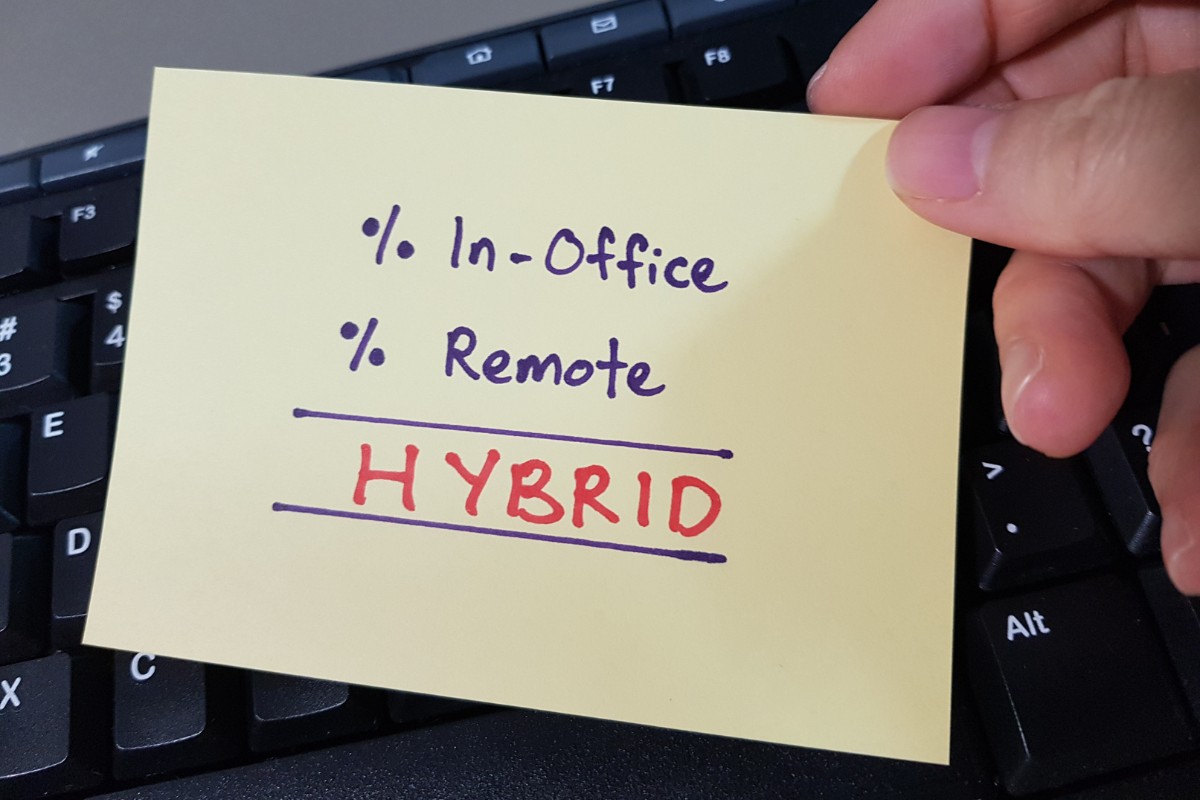The hybrid work ideal is not new, but it’s coming into its own since the pandemic lockdowns.
More employers than ever are offering a hybrid work environment for employees today.
You will soon find that it’s more popular and trending than you thought once you see the following hybrid work statistics that we have researched for you.
In this article, you will learn more about what hybrid work is, how employees and employers view it, and the benefits and challenges of working in the hybrid workplace.
Without further ado, let’s get into the nitty gritty of hybrid work statistics.
Post Contents
- 1 Key Statistics
- 2 Top Hybrid Work Statistics in 2024
- 2.1 1. 74% of employers now offer hybrid work options.
- 2.2 2. 90% of companies provide at least one voluntary benefit to their hybrid employees.
- 2.3 3. As of 2023, 28.2% of full-time employees are hybrid workers.
- 2.4 4. 58% of surveyed employees said they are more productive in their hybrid work role.
- 2.5 5. 59% of people say they are more likely to work for an employer with remote/hybrid options.
- 2.6 6. Hybrid employees work remotely an average of 3.3 days per week.
- 2.7 7. After the pandemic lockdowns, the number of hybrid workers increased from 13% to 24% in 2022.
- 2.8 8. 74% of Gen Z employees prefer face-to-face collaboration than Gen X and Baby Boomers.
- 2.9 9. 84% of employees who worked remotely during the pandemic say they favor hybrid work.
- 2.10 10. 34% of hybrid workers said they would prefer to work from home all the time.
- 2.11 11. 71% of hybrid workers say their managers trust them.
- 2.12 12. 42.2% of Gen Z work between one and two days remotely each week.
- 2.13 13. Organizations that have transitioned to the hybrid work model have seen a reduction of 40% in workplace costs.
- 2.14 14. Statistics show that only about 22% of the total global workforce is working fully onsite.
- 2.15 15. Hybrid workers report saving an average of $19.11 per day by commuting less.
- 3 FAQs
- 4 Conclusion
Key Statistics
- 74% of employers now offer hybrid work options.
- 90% of companies provide at least one voluntary benefit to their hybrid employees.
- As of 2023, 28.2% of full-time employees are hybrid workers.
- 58% of surveyed employees said they are more productive in their hybrid work role.
- 59% of people say they are more likely to work for an employer with remote/hybrid options.
- Hybrid employees work remotely an average of 3.3 days per week.
- After the pandemic lockdowns, the number of hybrid workers increased from 13% to 24% in 2022.
- 74% of Gen Z employees prefer face-to-face collaboration than Gen X and Baby Boomers.
- 84% of employees who worked remotely during the pandemic say they favor hybrid work.
- 34% of hybrid workers said they would prefer to work from home all the time.
Top Hybrid Work Statistics in 2024

1. 74% of employers now offer hybrid work options.
The 2022 International Foundation of Employee Benefits Plans (IFEBP) survey revealed that 74% of employers now offer hybrid work arrangements.
That’s nearly three-quarters of modern companies.
This is likely due to the pandemic which created the need for workers to keep working remotely.
Once the pandemic slowed and the lockdowns ended, many companies realized the benefit of remote and/or hybrid work.
(Forbes, IFEBP Blog, IFEBP Survey)
2. 90% of companies provide at least one voluntary benefit to their hybrid employees.
While we’re on the topic of employers that offer hybrid work, we will address how many of them offer employee benefits.
According to this survey, 90% of hybrid work employers provide at least one voluntary benefit to employees.
This can include but isn’t limited to life, vision, accident, or critical illness insurance, legal services, identity left services, hospital indemnity insurance, and pet coverage.
(IRFBP Survey)
3. As of 2023, 28.2% of full-time employees are hybrid workers.
We found out that 28.2% of employees work in the hybrid work category.
For perspective, only 12.7% of full-time employees work solely from home.
This statistic shows us the overwhelming preference of the hybrid work model among full-time workers.
Remote work is also on the rise, but the hybrid work ideal is giving employees the best of all possible workplace worlds.
(Forbes Advisor)
4. 58% of surveyed employees said they are more productive in their hybrid work role.
Over half (58%) of employees from a McKinsey survey said that they are more productive in the hybrid work setting.
Another 54% said that diversity and inclusion is better in this work model.
Additionally, this survey revealed that employee engagement saw a solid boost of 45%.
Plus, customer satisfaction improved by 36%.
When employees are happy, so are the customers they serve.
(McKinsey, Quixy)
5. 59% of people say they are more likely to work for an employer with remote/hybrid options.
Today’s working people do have preferences in how and where they work.
In fact, 59% of people nowadays are more apt to work for a company that offers hybrid or remote work options than companies that don’t.
The reasons for this rank highest for better pay (47%), more career opportunities and advancements (27%), and flexibility (21%).
(Officernd, Zippia)
6. Hybrid employees work remotely an average of 3.3 days per week.
Out of the full-time employees in the hybrid workforce, they work an average of 3.3 days from home and the rest at the office another 12% of survey respondents who work for companies that offer only occasional or part-time remote work say that they work from home 5 days per week.
This data shows some contradiction in just how much flexibility employers are offering compared to what workers really want.
(McKinsey & Company)
7. After the pandemic lockdowns, the number of hybrid workers increased from 13% to 24% in 2022.
According to statistics, hybrid workers increased by 13% to 24% between February 2022 to May 2022.
This shows significant growth in the hybrid workforce.
This is likely due to how comfortable companies and employees got with remote and hybrid work during the pandemic.
(Quizy)
8. 74% of Gen Z employees prefer face-to-face collaboration than Gen X and Baby Boomers.
A study revealed that 74% of Gen Z workers want more face-to-face collaborations in their remote/hybrid work environments.
Compare this to 66% of Gen X workers and 68% of Baby Boomer employees that share this ideal.
(Officernd)
9. 84% of employees who worked remotely during the pandemic say they favor hybrid work.

One survey showed that 84% of people who worked in the remote workforce during the pandemic say they would prefer the mix of working from home and working at the office, which is hybrid work.
This value among hybrid and remote workers hasn’t changed much since then.
(ONS, Quixy)
10. 34% of hybrid workers said they would prefer to work from home all the time.
According to a Pew Research survey, 34% of employees currently working in hybrid rolls would prefer to work from home all the time if they were given the choice.
That’s over one-third of hybrid workers who participated in the survey.
(Pew Research Center)
11. 71% of hybrid workers say their managers trust them.
The Pew Research Center survey also revealed that 71% of telework employees in hybrid roles say that their managers/supervisors trust and count on them to get their work done.
Another 79% of those who work solely at home said they feel mostly trusted compared to 67% of those working in hybrid roles.
(Pew Research Center)
12. 42.2% of Gen Z work between one and two days remotely each week.
In terms of generational hybrid workers, 42.2% of Gen Z hybrid employees work one to two days from home.
Another 30.4% of this age group works three to four days from home.
For perspective, 34.5% of Millennials work one to two days from home and 37.8% three to four days from home (remote).
Among both Gen X and Baby Boomers, 28.3% work one to two days from home and 36.4% three to four days from home.
(Zippia)
13. Organizations that have transitioned to the hybrid work model have seen a reduction of 40% in workplace costs.
Data shows that companies that have implemented the hybrid work model are seeing a 40% reduction in workspace costs on average.
Moreover, they have also reduced their employee turnover rates by 12%.
Employee turnover costs include the expenses from onboarding new employees and their lack of experience costs companies in productivity.
(Officernd)
14. Statistics show that only about 22% of the total global workforce is working fully onsite.
An Owl Labs survey found that only 22% of the world’s employees are currently working full-time onsite.
Furthermore, the study showed that 62% are working in hybrid roles and 16% are working in fully remote positions.
(Owl Labs, Quixy)
15. Hybrid workers report saving an average of $19.11 per day by commuting less.

A survey of hybrid workers shows that they are saving $19.11 per day by not commuting to work five days per week.
This converts to about $5,000 in savings annually for hybrid workers.
This is only one of the benefits of working in the hybrid workspace, but it’s a big one.
Some workers are willing to take pay cuts just to work in hybrid or remote roles.
(Officernd)
FAQs
What is hybrid work?
The hybrid work concept is one where employers allow employees to work from home and on-site.
Some hybrid work arrangements are flexible, allowing employees to choose what days they work from home and what days they work in the office.
Others have specific days and hours employees will work from home and on-site.
What are the benefits of hybrid working arrangements?
There are a lot of benefits that accompany hybrid work.
Here are some we found:
1. Better work-life balance: One of the things employees want today is more control over work schedules. Having more control and more flexibility allows for a better work-life balance.
2. Fewer work commute expenses: If you have ever commuted to work, you know how much money is spent on fuel and other car upkeep expenses. When you can commute less, you save on fuel and wear and tear on your vehicle.
3. Improved productivity: According to the statistics in this article, we found that hybrid workers are overall more productive than those who solely work in the office or from home. It’s like the best of both worlds.
4. Higher employee satisfaction: Employee satisfaction is how companies can reduce employee turnover. Hybrid workers are happier and more satisfied with their jobs than workers who work exclusively from home or in an office.
What are some challenges of hybrid work?
Just like with anything in life, the hybrid work ideal also comes with challenges.
While the benefits usually outweigh these challenges, we feel you should know these challenges:
1. Lack of the sense of community: Sometimes employees enjoy working at the office and engage with their coworkers in person. Since hybrid workers have more control over their schedules, they can decide when they want to engage in the office.
2. Maintaining communication, teamwork, and collaboration: It’s challenging enough to maintain good communication, teamwork, and collaboration at the office, but with the remote and hybrid ideals, it can be more challenging. Collaboration and communications must include solid and consistent online tools to support the team effort.
3. Remote/Hybrid work management: There are plenty of challenges in the office workplace already, but sometimes hybrid work creates more challenges. Managers must learn to adapt and change their management style for remote work and office work combined. It takes a lot of thought, time management, and people skills to switch back and forth.
What is the future of hybrid work?
The concept of hybrid work is still relatively new to the workplace scene, so its future is uncertain.
We did find these hybrid work trends that we may see in the near future:
1. An uptake in hiring hybrid workers.
2. More advancements in new technologies to raise the efficacy of hybrid work.
3. Office space accommodations will evolve to better aid hybrid workers.
What are some hybrid work best practices?
In terms of how organizations handle the hybrid work ideal, we have some best practices to help.
1. Clear and concise expectations: Employees in any workplace environment need clear and concise expectations to do their work effectively for the company. Without clear expectations, you will see a decrease in productivity. You need to be sure to set clear hours, and communication and collaboration expectations.
2. Check in with employees often: This doesn’t mean you need to micromanage your employees. It means you should regularly check in to find out if they need support or help with anything. It’s a common courtesy that lets them know they are more than just a number.
3. Create relationships and trust: Your company needs to have a trusting culture. Your employees need to know that you trust them to work from home just like they do in the office. Be flexible and let your employees work in ways that reflect their individual needs.
4. Give them the right resources and tools: One of the most important things you can do for your employees and your company is to provide the necessary tools and resources needed to do the job. This includes internet access, essential software, laptop, desktop, or other devices, and the tools needed to ensure effective and efficient workplace communication and collaboration.
Conclusion
If you’re an organization that hires employees that isn’t offering hybrid work options, you may consider it after reading this data.
Almost every company has at least some roles that can be performed from home and/or the office combined.
If you’re an employee working in the hybrid environment, you may have seen the benefits and can relate to these statistics.
If you’re working solely in the office, you may now be reconsidering trying to find hybrid work or asking your employer about it.
If you’re a marketer, brand, or business, you should now have some ideas for how to adapt your marketing strategy to meet the needs of hybrid workers.
No matter who you are or where you live, we hope this hybrid work statistics article has opened your eyes to the hybrid workplace and how it works.






























